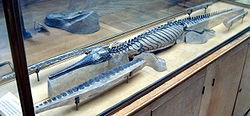- Pelagosaurus
-
Pelagosaurus
Temporal range: 183–176 Ma Toarcian
Cast of Pelagosaurus typus (skeleton and scutes) at Muséum national d'histoire naturelle, Paris Scientific classification Kingdom: Animalia Phylum: Chordata Class: Sauropsida Subclass: Diapsida Infraclass: Archosauromorpha (unranked): Mesoeucrocodylia Suborder: Thalattosuchia Family: Teleosauridae Genus: Pelagosaurus
Bronn, 1841[1]Binomial name Pelagosaurus typus
Bronn, 1841[1]Synonyms - Mosellaesaurus Monard, 1846
Pelagosaurus (meaning "lizard of the open sea") is an extinct genus of thalattosuchian crocodyliform that lived during the Toarcian stage of the Lower Jurassic, around 183 Ma to 175 Ma (million years ago), in shallow epicontinental seas that covered much of what is now Western Europe. The systematic taxonomy of Pelagosaurus has been fiercely disputed over the years, and was assigned to Thalattosuchia after its systematics within Teleosauridae were disputed. Pelagosaurus was markedly similar to the modern-day gharial, which has similar adaptions and carnivorous feeding habits.
Contents
Discovery
Pelagosaurus was originally described from a specimen from Normandy, but the holotype for P. typus was discovered north of the town of Ilminster in Somerset, England. Most Pelagosaurus remains have been found in the Ilminster area, but numerous other remains, predominantly skulls and articulated skeletons, have been found around Western Europe in locations such as France and Germany. Specimens from the Somerset region come primarily from the Strawberry Bank quarry north of Ilminster; although the site had yielded other fossil remains before, the site has since been built over. One of the specimens was that of a small juvenile, providing some insight into Pelagosaurus' growth pattern.[2]
Evolutionary relationships
The evolutionary relationships of Pelagosaurus has been confusing as there have been three different interpretations as to where in Thalattosuchia it belongs:
- Teleosaurid: The teleosaurid classification of Pelagosaurus, based upon anatomical similarity, was maintained by Eudes-Deslongchamps, Westphal and Duffin.[3][4][5][6][7]
- Metriorhynchid: Its position as a basal metriorhynchid was made by Buffetaut.[8][9]
- Basal thalattosuchian: However, phylogenetic analyses from the 1980s, 1990s and early 2000s found Pelagosaurus to be the sister taxon to both Teleosauridae and Metriorhynchidae.[10][11][12]
The most recent phylogenetic analyses have all found Pelagosaurus to be a basal teleosaurid,[13][14][15] rather than a basal metriorhynchid or thalattosuchian.
Palaeobiology
Pelagosaurus was well adapted to aquatic life; it had developed a long, streamlined snout, a tail with fin-like attributes and paddle-like limbs for swimming in the warm, shallow waters of its time. Pelagosaurus had 30 teeth suitable for hunting and grasping fish, crustaceans and insects whilst swimming; indeed, one fossil specimen was found with a Leptolepis— an early teleost fish— in its stomach contents. Its forward-facing eyes and streamlined body suggest that Pelagosaurus was a pursuit predator, rather than a scavenger or ambush hunter. Pelagosaurus was markedly similar to modern crocodiles, and would have swum in much similar manner, whipping its tail from side to side, although its veterbral structure was slightly more agile, probably allowing for more movement in the water than its modern equivalents. Pelagosaurus would have only emerged from the water to lay eggs or to rest on the banks, and would have spent the rest of its day in the water for which it was adapted.[2]
See also
References
- ^ a b Bronn HG. 1841. Über die fossilen Gaviale der Lias-Formation und der Oolithe. Archiv für Naturgeschichte, Berlin 8:77–82.
- ^ a b Pierce SE, Benton MJ. 2006. Pelagosaurus typus Bronn, 1841 (Mesoeucrocodylia: Thalattosuchia) from the Upper Lias (Toarcian, Lower Jurassic) of Somerset, England. Journal of Vertebrate Paleontology 26 (3): 621–635.
- ^ Eudes-Deslongchamps JAE. 1863. Mémoire sur les Téléosauriens de l’époque Jurassique du Département de Calvados. Mémoires de la Société Linnéenne de Normandie 13:1–138.
- ^ Eudes-Deslongchamps EE. 1877. Le Jura Normand, 4. F. Savy (ed). Paris. 60 pp.
- ^ Westphal F. 1961. Zur Systematik der deutschen und englischen Lias Krokodilier. Neues Jahrbuch für Geologie und Paläontologie, Abhandlungen 113:207–217.
- ^ Westphal F. 1962. Die Krokodilen des deutschen und englischen oberen Lias. Palaeontographica, Abteilung A 118:1–96.
- ^ Duffin CJ. 1979. Pelagosaurus (Mesosuchia, Crocodilia) from the English Toarcian (Lower Jurassic). Neues Jahrbuch für Geologie und Paläontologie, Monatshefte 1979:475–485.
- ^ Buffetaut E. 1980. Position systématique et phylogénetique du genre Pelagosaurus Bronn, 1841 (Crocodylia, Mesosuchia), du Toarcian d’Europe. Geobios 13:783–786.
- ^ Buffetaut E. 1982. Radiation évolutive, paléoécologie et biogéographie des crocodiliens mésosuchiens. Mémoires de la Sociéte Géologique de France 42:1–88.
- ^ Benton MJ, Clark JM. 1988. Archosaur phylogeny and the relationships of the Crocodylia; pp. 295–338 in MJ. Benton (ed.), The phylogeny and classification of the tetrapods, Vol. 1. Amphibians, Reptiles, Birds. Systematic Association Special Volume 35A. Clarendon Press, Oxford.
- ^ Clark JM. 1994. Patterns of evolution in Mesozoic Crocodyliformes; pp. 84–97 in NC. Fraser and H-D. Sues (eds.), In the shadow of the dinosaurs: Early Mesozoic tetrapods. Cambridge University Press, Cambridge and New York.
- ^ Buckley GA, Brochu CA, Krause DW, Pol D. 2000. A pugnosed crocodyliform from the Late Cretaceous of Madagascar. Nature 405:941–944.
- ^ Mueller-Töwe IJ. 2005. Phylogenetic relationships of the Thalattosuchia. Zitteliana A45: 211–213.
- ^ Gasparini Z, Pol D, Spalletti LA. 2006. An unusual marine crocodyliform from the Jurassic-Cretaceous boundary of Patagonia. Science 311: 70-73.
- ^ Young MT. 2007. The evolution and interrelationships of Metriorhynchidae (Crocodyliformes, Thalattosuchia). Journal of Vertebrate Paleontology 27 (3): 170A.
Thalattosuchia Metriorhynchidae Cricosaurus · Dakosaurus · Geosaurus · Gracilineustes · Metriorhynchus · Neptunidraco · Neustosaurus · Purranisaurus · Suchodus · Rhacheosaurus · Eoneustes · Teleidosaurus · TorvoneustesTeleosauridae Related categories Marine crocodiles · Jurassic crocodylomorphs · Cretaceous crocodylomorphsCategories:- Marine crocodiles
- Jurassic crocodylomorpha
Wikimedia Foundation. 2010.


